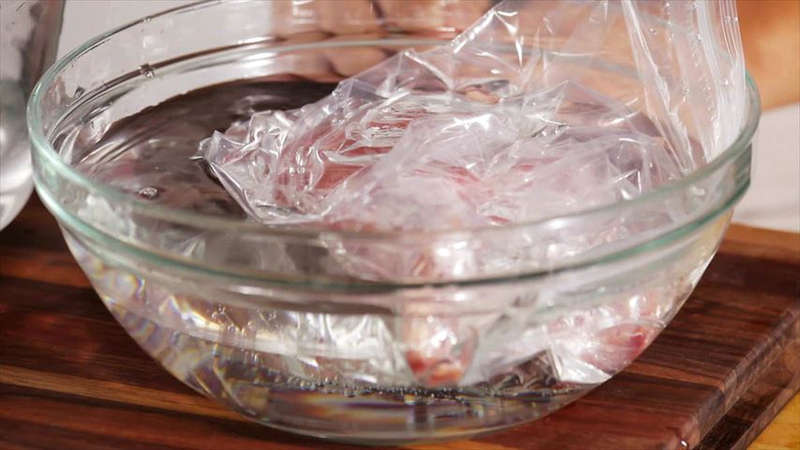Ok. Let's say you are home, but never remembered to get something thawed for dinner. You reach for a package of chicken or meat and thaw it speedily using hot water. But how safe is this? What if you removed food from the freezer, but mistakenly left the food sitting on your counter all the time you were away at work?
None of these two situations can be considered safe, and these thawing methods can lead to food-borne diseases. Cooked or raw meat, poultry products like egg, or any such perishable foods, must be stored at a very safe temperature during the thawing process. They remain safe while in their frozen state. However, once they start thawing under a temperature above 40°F, bacteria that were present before the food got frozen can start multiplying.
There are 4 different safe ways of thawing food: in the microwave, in cold water, in the fridge, and the last choice.

How to Defrost Meat Fast: 4 Different Methods to Thaw Food Safely & Quickly
Use Microwave
This is one of the fastest methods for how to defrost meat fast, which lasts between 5-10 minutes, but needs lots of attention to avoid having a semi-cooked tough and stringy meat. Check your microwave user manual to know the exact mode for the meat you are about to thaw as well as its weight. Periodically check the food and take it away the moment it has been defrosted. For optimum results, have thinner portions of the meat positioned at the center of the microwave, where overcooking is less likely to occur.
Use Cold Water
A cold water bath is a very good option when you plan to have the food cooked immediately and the meat thawed quickly. However, this will require lots of attention, so it won't be as easy as it is to put things in the fridge and get them off your mind.
You need to have your food wrapped in a well-sealed plastic bag. Ensure no leaks occur. If the frozen food came in a plastic container, for precautionary measures, you can have it thrown into a Ziploc bag. Since submerging this is going to happen in winter, it is better to be safe than to be sorry.
Get a bowl where you can fill your frozen food and get it filled with cold water. Get your sealed food submerged in the water. Whenever it comes to room temperature, you will be able to change the water easily. This takes about 30 minutes on average, but the time may vary due to the climate, so you need to pay attention.
The size and nature of the food you wish to defrost determines how long it takes for your food to defrost: your food can defrost in less than an hour, but larger foods like whole turkey can take as much as 3 hours before it gets defrosted.
Use Refrigerator
This one of the easiest tips you get ever come across on how to defrost meat fast – just get it stuck in the refrigerator and give it time to thaw.
But it may take a little longer than you planned to wait. Usually, it takes a whole day to get the smallest amount of frozen food thawed, some of these foods can include one pound of ground meat or chicken breast with no bones. For bigger items, such as ham or whole turkey, it will require up to 24 hours of defrosting time for each 5 pounds of food.
Though all the waiting will pay off in the end. One good advantage of using the refrigerator to thaw your food is that you don't need to have defrosted food cooked immediately – this is most helpful when you get faced with an eleventh hour change of plans.
Poultry products, ground meat and fish that have gone through defrosting in the refrigerator can be kept for 1-2 days in the fridge before cooking commences. Beef, lamb, veal or lamb (roasts, chops or steaks) will stay refrigerated for about 3-5 days longer after the whole thawing process. If you make up your mind not to have this thawed food cooked, you can refreeze it safely within these exact time limits.
NB: To stop the growth of bacteria, get all the meat cooked immediately after it has been thawed.
Last Choice: No Thawing
Yes, no thawing at all. When there is no adequate time for thawing the frozen foods, or you are in a hell of a hurry, just don't forget this: cooking foods from the frozen state is quite safe. The cooking naturally takes about 50% longer than the time recommended for fresh poultry products and meat that has been freshly thawed.
- You must avoid thawing perishable foods on the counter. Thawing them in hot water is not the best idea, neither is letting it stay at room temperature longer than 2 hours.
- Though the center of the package may remain frozen while the thawing continues at the counter, it is possible for the outer layer of the foods to be in the Danger Zone between 40°F and 140°F – temperatures at which the bacteria multiply very speedily.
- When getting frozen food thawed, the best thing is to prepare ahead of time and have it thawed in the fridge where it is possible to maintain a safe stable temperature, about 40°F or less.

View All Comments /Add Comment